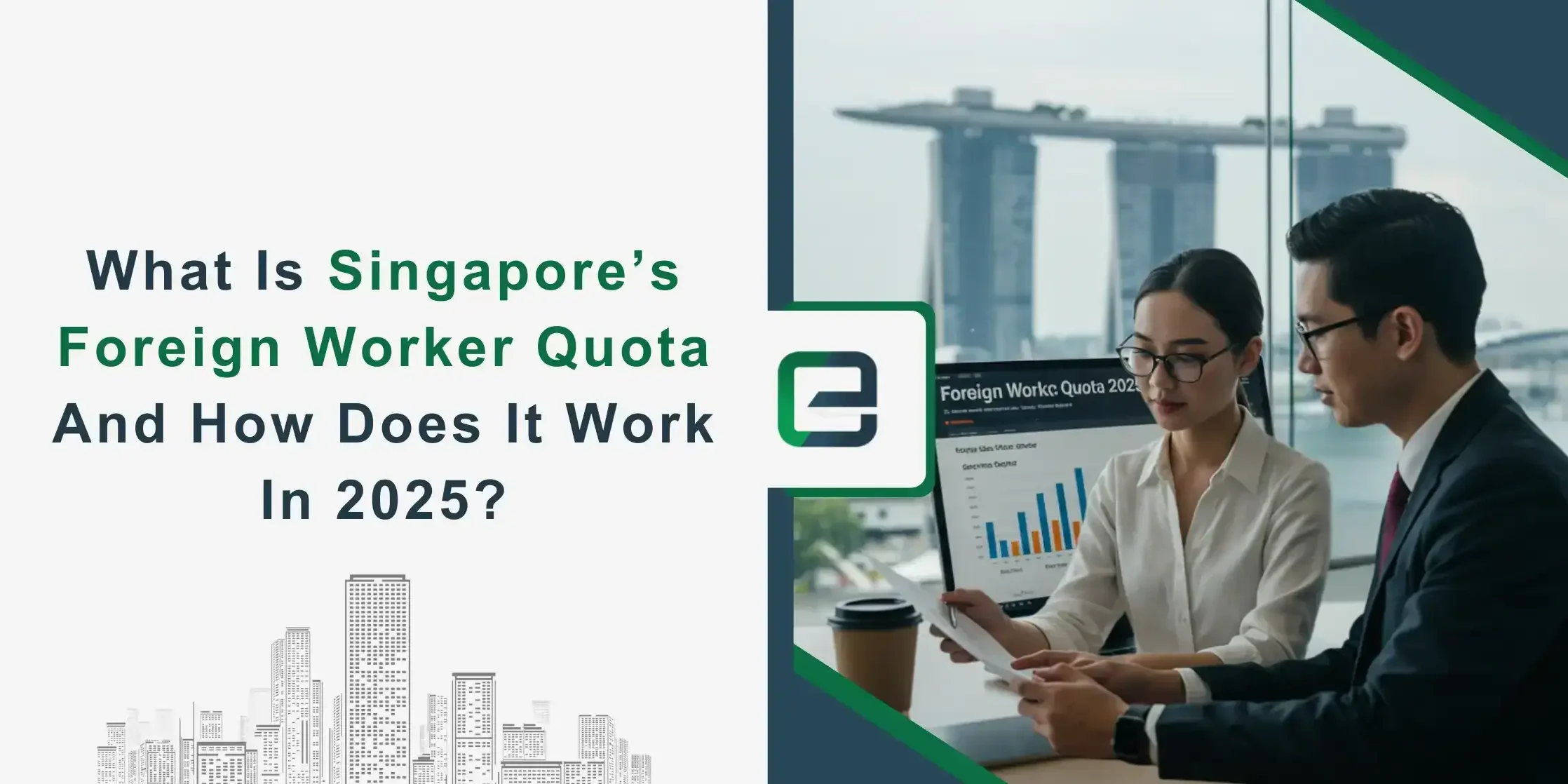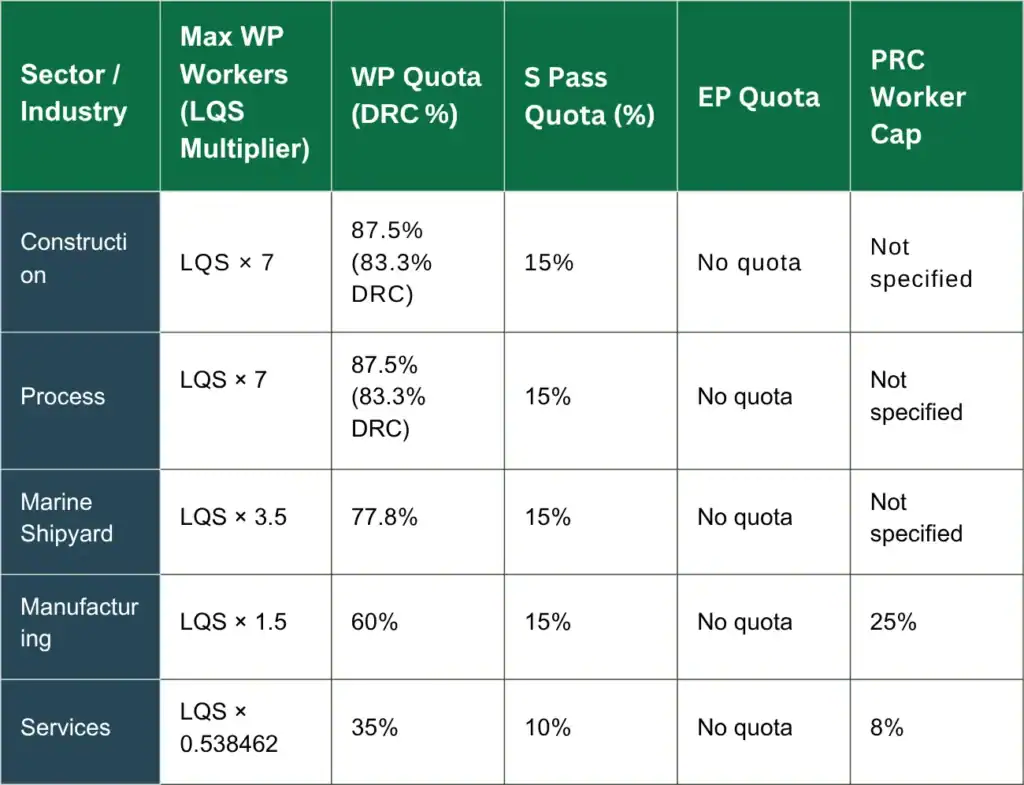Singapore, a vibrant Asian economy, strategically manages its workforce by balancing local talent and foreign expertise. This equilibrium is maintained through the pivotal Foreign Worker Quota policy, which sets the maximum number of foreign employees a business can hire. This measure helps manage the inflow of foreign workers and ensures ample employment opportunities for Singaporean citizens. It also incentivises employers to strengthen the local workforce and reduce reliance on foreign labour. As of June 2024, over 1.5 million foreign workers were employed in Singapore, accounting for approximately 40% of the workforce.
With stricter enforcement expected in 2025, businesses must understand the quota framework, the foreign worker levy in Singapore, and how tools like the quota calculator can ensure compliance. Whether you’re exploring employment in Singapore for foreigners, applying for a work permit, or planning company incorporation in Singapore, this guide breaks it down.
What is the Foreign Worker Quota in Singapore?
The Foreign Worker Quota in Singapore restricts a company’s number of foreign employees. This helps the government manage the inflow of foreign workers and ensure adequate employment opportunities for Singaporean citizens. This policy encourages companies to hire more local workers and reduce their dependence on foreign workers.
What are the Categories of Foreign Workers in Singapore?
Foreign workers in Singapore are categorised primarily into four groups:
- Work Permit (WP) Holders—Semi-skilled workers from approved countries in construction, manufacturing, marine, and services industries.
- S Pass Holders – For mid-level skilled staff earning a minimum qualifying salary.
- Employment Pass (EP) Holders—This category is for professionals, managers, and executives with higher qualifications and salaries.
- Overseas Networks & Expertise Pass (ONE Pass) – A special category for top global talent in areas like business, tech, arts, and academia. The ONE Pass is not tied to any employer, valid for 5 years, and is not subject to any quota or levy.
Each category has criteria, quotas, and levy rates under MOM regulations.
Who is Eligible for a Work Permit in Singapore?
To qualify for a Work Permit in Singapore:
- The applicant must be from a MOM-approved country.
- The job must fall under eligible sectors: construction, manufacturing, marine shipyard, process, or services.
- Employers must adhere to quota and levy requirements.
- Workers must pass medical exams and comply with insurance and housing standards.
Example: A construction company can hire a Bangladeshi mason under the Work Permit scheme if it stays within its quota and the worker meets MOM’s health and documentation standards.
How does the Foreign Worker Quota and DRC System Work in 2025?
The Dependency Ratio Ceiling (DRC) governs how many foreign workers you hire relative to local employees. This is calculated as:
Foreign Worker Quota = Local Qualifying Salary (LQS) staff x DRC ratio
For example:
- In construction, the DRC is 87.5%, meaning you can hire seven foreign workers for every one local employee (LQS x 7).
- In services, the DRC is much lower at 35%.
Companies must regularly update their LQS count and use the Quota Calculator on the MOM portal to avoid violations.
Check our Guide: Guide to Calculating Foreign Worker Quota in Singapore
What is the Foreign Worker Levy in Singapore?
The foreign worker levy is a pricing mechanism to regulate the demand for foreign labour. It varies by:
- Industry sector
- Worker skill level (Basic or Higher-Skilled)
- Tier (based on how many workers are hired relative to the quota)
Example (Manufacturing Sector):
- Basic-skilled workers: SGD 450/month
- Higher-skilled workers: SGD 300/month
Paying levies on time and staying within your quota avoids penalties or work pass cancellations.
Indonesia’s economy is more diversified, with significant contributions from manufacturing, agriculture, services, and an increasingly crucial digital sector. The country’s vast population of over 270 million provides a substantial domestic market, making it particularly attractive for consumer-focused businesses.
How is the Foreign Worker Quota Determined and Calculated?
The quota is calculated based on your company’s number of local employees, as reported through CPF (Central Provident Fund) contributions. As of July 2024, the Local Qualifying Salary (LQS) has increased to SGD 1,600/month, up from SGD 1,400
What Are the Quotas for Work Permit, S Pass and Employment Pass Holders?
The Ministry of Manpower (MOM) calculates the quota limit for each industry based on the proportion of foreign and local employees in the respective sectors. The MOM also reviews the quota system regularly and adjusts the limits if necessary to maintain a balance between local and foreign labour.
Singapore Foreign Worker Quota by Sector (2025)
Note:
- LQS (Local Qualifying Salary) determines the number of locals counted towards your quota.
- EP (Employment Pass) holders are not subject to quotas, but must meet salary thresholds (SGD 5,000 or SGD 5,500 for financial services).
- For full quota compliance, use the MOM Quota Calculator.
What are the Foreign Worker Quota Rules for F&B and Self-Employed Business?
Singapore applies different foreign worker quota rules depending on the nature of the business. Both the F&B sector and self-employed individuals must comply with strict limits and levy obligations to maintain eligibility for hiring foreign workers.
Foreign Worker Quota for the F&B Sector
Singapore’s Food & Beverage (F&B) industry relies heavily on the workforce, especially in kitchens and service roles. To maintain a balance between local employment and foreign workforce reliance, the following quota rules apply:
- Work Permit (WP) Quota: 35% of the workforce can be foreign WP holders.
- S Pass Quota: Up to 10% of the total workforce.
- Foreign Worker Levy: Tiered monthly levy rates depending on the worker count and dependency ratio.
- Eligibility for Government Schemes: Companies may be eligible for support schemes like the Productivity Solutions Grant (PSG) or the Capability Development Grant (CDG) if they maintain compliance.
Example:
If your F&B outlet has 20 local employees earning at least SGD 1,400/month (with valid CPF contributions), you can hire:
- 7 foreign workers on Work Permits (35% of the total workforce of 20 locals + 7 foreigners, ≈ 27 staff)
- Up to 3 S Pass holders, considering the 10% cap on total workforce size
Ensure your local headcount qualifies under the Local Qualifying Salary (LQS).
Foreign Worker Quota for Self-Employed Individuals
Self-employed persons or business owners operating as sole proprietors face more limitations under the foreign workforce policy:
- Quota Limit: Only one foreign worker can be hired, regardless of business type.
- Dependency Ceiling: Where applicable, the foreign worker must not exceed 20% of the workforce.
- Levy Requirements: A monthly levy is still mandatory, and timely payment is crucial to retain work permit validity.
Example:
A freelance baker operating under a sole proprietorship with no local employees may be allowed to hire only one foreign assistant, subject to a 20% cap if employing multiple workers. This ensures fairness while allowing small businesses to access an essential workforce.
How can the company’s Foreign Worker Quota be Calculated Using the Quota Calculator?
Singapore’s MOM Quota Calculator helps businesses determine the maximum number of work permits and S-pass holders they can employ based on the number of eligible local employees (based on CPF contributions). Singapore’s Quota Calculator on the MOM website lets employers:
- Input local employee numbers
- Check foreign worker limits
- Determine how many WP or S Pass holders they can legally employ
- See real-time eligibility based on industry
Example:
A services company with eight full-time local employees earning at least SGD 1,600 monthly qualifies for a local headcount of 8. Under the 2025 quota rules, the Work Permit quota for the services sector is 8 × 0.538462, which comes to approximately 4 Work Permit holders. The S Pass quota also allows for up to 10% of the total workforce, translating to 1 S Pass holder. Therefore, this company can legally employ up to 4 Work Permit holders and 1 S Pass holder while remaining compliant with Singapore’s Foreign Worker Quota.
Conclusion:
Understanding and complying with the Foreign Worker Quota is vital for businesses looking to maintain a sustainable workforce in Singapore. With varying rules based on sector and pass type—Work Permit, S Pass, or Employment Pass—employers must also manage the foreign worker levy obligations and stay updated using tools like the quota calculator. Accurate CPF records and careful workforce planning can help avoid penalties and ensure full compliance under the Singapore quota foreign workers 2025 guidelines.
At 3E Accounting, we specialise in helping companies navigate Singapore’s workforce regulations—from work permit applications to strategic employment planning for foreigners. Whether launching a new venture or expanding your team, our expert guidance ensures you stay compliant while building a productive and balanced workforce.
Ready to grow your team the right way? Contact 3E Accounting today for tailored support on foreign worker quota matters and seamless company incorporation in Singapore
Stay compliant with Singapore’s latest foreign worker policies.
Partner with 3E Accounting to manage your Work Permits, S Pass, and foreign workforce efficiently.
Frequently Asked Questions
In Singapore a monthly fee is imposed on each foreign worker, depending on industry and ratio of locals to foreigners.
Yes, S Pass holders are subject to sector-specific quotas. For example, in 2025, the S Pass quota is 10% for the services sector and 15% for manufacturing. Employment Pass (EP) holders are not subject to quota limits but must meet higher salary thresholds.
Yes. The MOM Quota Calculator allows companies to check their eligible foreign worker headcount by entering their number of local employees and sector. It helps ensure you stay within the Singapore quota for foreign workers in 2025.
If a company exceeds its foreign worker quota, it will not be allowed to renew existing Work Permits or hire new foreign workers. MOM may also impose penalties and suspend hiring privileges.
The headcount of local employees used to calculate the quota is updated weekly based on CPF contributions. Maintaining up-to-date salary and CPF records is critical to staying compliant.

Abigail Yu
Author
Abigail Yu oversees executive leadership at 3E Accounting Group, leading operations, IT solutions, public relations, and digital marketing to drive business success. She holds an honors degree in Communication and New Media from the National University of Singapore and is highly skilled in crisis management, financial communication, and corporate communications.











